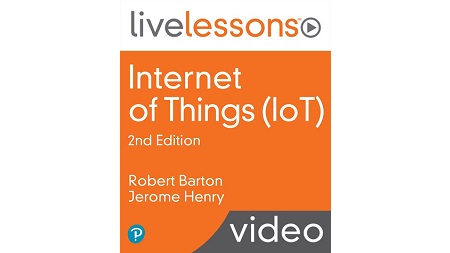
English | MP4 | AVC 1280×720 | AAC 44KHz 2ch | 8h 52m | 1.88 GB
The Internet of Things (IoT) is rapidly gaining popularity worldwide and is becoming one of the most important drivers for digital transformation. It is an important topic demanded by various markets, including networking, cloud, DevOps, security, and more. Internet of Things (IoT) LiveLessons, 2nd Edition introduces you to the technical foundations of IoT, from the sensors and actuators, through secure IoT network access technologies, all the way to the core aspects of big data analytics and machine learning. It also covers the key components of an IoT network and details how various IoT cloud platforms like Azure IoT Hub and AWS IoT Core support their IoT projects.
Taught by experienced Cisco IoT experts Robert Barton and Jerome Henry, the course teaches you the basics but also the knowledge and the skills to start an IoT project that incorporates the key business drivers that make IoT an important area of technology. Internet of Things (IoT) LiveLessons, 2nd Edition is organized into 14 lessons that include several demos and many real-world deployment examples and case studies that the instructors have personally led.
Topics Include
- An introduction to IoT
- Connecting and securing IoT devices
- Using Raspberry Pi to start an IoT project
- Moving IoT data from the edge to the cloud
- IoT cloud platforms
- Developing an IoT project and looking forward
Learn How To
- Plan, organize, build, and deploy end-to-end IoT solutions
- Navigate today’s IoT product marketplace
- Manage IoT projects with cloud-based solutions
- Set up your Raspberry Pi to kickstart an IoT project
- Use maturing IoT technologies to solve many business and technical problems
- Make sense of the full IoT protocol stack, including wired and wireless technologies and the management protocols that make IoT work
- Understand the world of operational technology (OT) and how it intersects with IT
- Architect IoT networks for maximum security and integrity
- Generate meaningful intelligence from the data your smart objects capture
- Move data from the IoT edge to popular cloud-based IoT services, such as AWS and Azure
- Plan out an IoT project by working through cross-functional teams
Table of Contents
Module 1: An Introduction to IoT
Lesson 1: What is IoT Anyway?
1.1 IoT 101
1.2 Common IoT Use Cases
1.3 Comparing Industrial and Consumer IoT
1.4 IoT Reference Architectures
Lesson 2: Your IoT Network, from Bottom to Top
2.1 Sensors, Actuators, and Embedded Systems
2.2 Industrial IoT Components (PLCs, HMIs)
2.3 Access Network Components
2.4 IoT Applications
2.5 The Role of Data Analytics, AI/ML, Digital Twins
Lesson 3: IoT for Home Automation
3.1 A Survey of IoT Applications in the Home
3.2 Connecting IoT Objects in the Home
3.3 Using Raspberry Pi for Home Automation Projects
3.4 Getting Started on a Home Automation Project
3.5 Home Automation with Raspberry Pi (demo)
Module 2: Connecting and Securing IoT Devices
Lesson 4: Connecting IoT Devices with Wireless Technologies
4.1 Wireless Technologies
4.2 Using Wi-Fi to Connect IoT Devices
4.3 Low Power Protocols and their Applications
4.4 Case Study: Building Automation and Smart Grid
Lesson 5: Long Range Communication Methods for IoT
5.1 Use Cases and Challenges
5.2 Connecting IoT Devices over Cellular
5.3 Connecting IoT Devices Low Power Wide Area Networks (LPWANs)
Lesson 6: The World of Industrial IoT and Operational Technology (OT)
6.1 The Convergence of IT and OT
6.2 An introduction to SCADA
6.3 The Purdue Model for Industrial Automation
6.4 Synchronizing Timing of Industrial Devices
6.5 Resiliency for Industrial Networks
Lesson 7: Protecting IoT Devices and Data from Cyberattack
7.1 An introduction to IoT Cybersecurity
7.2 Understanding Threat Vectors and Targets
7.3 Anatomy of an IoT Cyberattack
7.4 Developing an IoT Security Blueprint
Module 3: Moving IoT Data from the Edge to the Cloud
Lesson 8: Communicating with IoT Devices
8.1 How we Communicate with IoT Devices
8.2 An Introduction to MQTT
8.3 Using CoAP to Communicate with IoT Devices
Lesson 9: IoT Data Management Tools
9.1 Edge and Fog Computing
9.2 Message Broker Systems
9.3 Using Raspberry Pi as an IoT Messaging System
9.4 Using NodeRed to Build an IoT Data Pipeline
Module 4: IoT Cloud Platforms
Lesson 10: IoT Cloud Platforms – AWS IoT Suite
10.1 AWS IoT Suite Components and Architecture
10.2 Working with AWS IoT Core
10.3 AWS IoT Suite (demo)
Lesson 11: IoT Cloud Platforms – The Azure IoT Suite
11.1 Azure IoT Suite Components and Architecture
11.2 Azure IoT Hub and IoT Central
11.3 Azure IoT Central (demo)
Lesson 12: IoT Cloud Platforms – Google Cloud IoT
12.1 Google Cloud IoT Components and Architecture
12.2 Working with Google Cloud IoT
Module 5: Developing an IoT Project and Looking Forward
Lesson 13: Developing an IoT Project
13.1 Evaluating the business drivers behind an IoT project
13.2 Scoping the project
13.3 Selecting the right technology platforms
13.4 Starting a project with Raspberry Pi (demo)
13.5 IoT case study: digitizing sensors in a smart building
13.6 Case study: Development of a Smart Bus IoT Project
Lesson 14: The Future of IoT
14.1 Putting it all together – course review, but what happens next?
14.3 Exploring hot areas of research
14.3 What does a career in IoT look like?
Resolve the captcha to access the links!